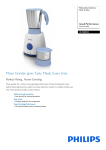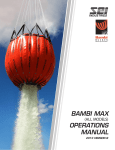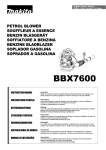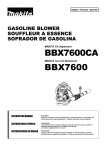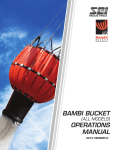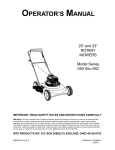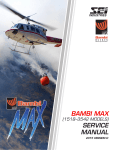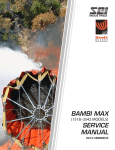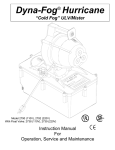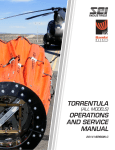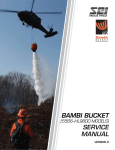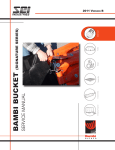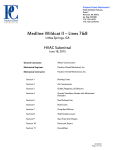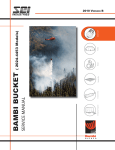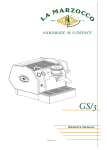Download Bambi MAX Service Manual (HL Series)
Transcript
BAMBI MAX (HL4000-9800 MODELS) SERVICE MANUAL 2014 VERSION A Photo courtesy of Dan Sweet BAMBI MAX SERVICE MANUAL - Models HL4000-9800 Version A Issue Date: August 2014 PLEASE READ BEFORE USING. SEI INDUSTRIES LTD. 7400 Wilson Avenue Delta, B.C. Canada V4G 1E5 Phone: (604) 946-3131 Fax: (604) 940-9566 E-Mail: [email protected] Website: www.sei-ind.com COPYRIGHT © 2014 SEI INDUSTRIES LTD. ALL RIGHTS RESERVED We Engineer Solutions 2014 Bambi MAX Service Manual – Models HL4000-9800 (Version A) Table of Contents Section 1: Introduction 1 Bambi MAX (HL4000-9800) .........................................................................................1 Valve System ................................................................................................................2 System Overview ............................................................................................2 System Description .........................................................................................2 Section 2: Deploying the Bambi MAX 6 Deployment Instructions ...............................................................................................6 Attaching to the Cargo Hook ..........................................................................6 Head Orientation ............................................................................................6 Connecting Power ..........................................................................................7 Using Longlines ..............................................................................................7 Instant Deployment System (IDS) ..............................................................................10 Section 3: Using Accessories 11 Using Foam ................................................................................................................11 Sacksafoam Foam Injection System ............................................................11 Compatible Bambi MAX/Sacksafoam Models ..............................................12 Bambi Mobility Sled ....................................................................................................13 Section 4: Making Adjustments 14 Adjusting Components ...............................................................................................14 Valve Adjustment ..........................................................................................14 Section 5: Packing and Storage 16 Packing and Storing ...................................................................................................16 Packing the Bucket .......................................................................................16 Storing the Bambi MAX ................................................................................20 Section 6: Troubleshooting and Maintenance 21 Troubleshooting ..........................................................................................................21 Valve Troubleshooting ..................................................................................21 Checking Aircraft / Longline Wiring ..............................................................22 Maintenance Procedures ............................................................................................23 Weekly Inspections .......................................................................................23 Weekly Inspection Checklist .........................................................................23 We Engineer Solutions 2014 Bambi MAX Service Manual – Models HL4000-9800 (Version A) Section 7: Valve Maintenance 24 MAX Valve Repair and Replacement .........................................................................24 Linkage Adjustment ......................................................................................24 Valve Removal .............................................................................................24 Valve Installation ..........................................................................................26 Bambi MAX Seal Replacement ....................................................................28 Drive Cable Replacement .............................................................................33 Changing the Guide Bushings ......................................................................37 Section 8: Repair Quick Guide 38 Overview of Repair Categories ...................................................................................38 Category 1: Safety ........................................................................................38 Category 2: Operational ...............................................................................38 Category 3: Monitor ......................................................................................38 Category 4: OKAY ........................................................................................38 Bucket Shell Repair Criteria .......................................................................................39 Cables Repair Criteria ................................................................................................40 IDS Hub Repair Criteria ..............................................................................................41 M-Straps and Top Chains Repair Criteria ..................................................................42 Control Head Repair Criteria ......................................................................................43 Section 9: General Repairs 44 Repair Instructions ......................................................................................................44 Suspension Line Replacement .....................................................................44 M-Strap Replacement ...................................................................................45 Removing Old M-Straps ...............................................................................46 Installing New M-Straps (Short) ....................................................................47 Installing New M-Straps (Long) ....................................................................49 Bottom Loop Repairs ....................................................................................51 Bucket Patching ............................................................................................51 IDS Hub/Spokes Replacement .....................................................................52 IDS Detailed Drawing ...................................................................................53 Load Test on the Hook .................................................................................53 Bambi MAX Shell Repairs ..........................................................................................54 Repair Failures .............................................................................................54 Repairing in High Humidity ...........................................................................55 Making Temporary Repairs with Sealing Clamps .........................................56 Temporary Repairs Using Glue ..................................................................................58 Applying the Glue .........................................................................................58 Gluing with Patches ......................................................................................59 Cutting the Patch ..........................................................................................60 Applying the Patch ........................................................................................60 Hot Air Gun Patching ..................................................................................................62 Hot Air Gun Procedure .................................................................................63 Repair Kits ..................................................................................................................64 Repair Kit Parts Table ..................................................................................64 Optional Supplies .........................................................................................64 We Engineer Solutions 2014 Bambi MAX Service Manual – Models HL4000-9800 (Version A) Section 10: Specifications and Parts 65 Capacity and Weight Specifications ...........................................................................65 Parts Listings ..............................................................................................................66 Bambi MAX Valve 28" Shell Assembly, Models HL4000-9800 ....................66 Bambi MAX Valve 28" Installation ................................................................67 Bambi MAX Valve 28" Seals ........................................................................68 Bambi MAX Valve 28" Actuator and Controller ............................................69 Bambi MAX Valve 28" Actuator ....................................................................70 Bambi MAX Valve 28" Actuator 2 .................................................................71 Bambi MAX Valve 28" Sheave Bar and Guide Rods ....................................72 Bambi MAX Valve 28" Lift Bar and Linkage .................................................73 Bambi MAX Valve 28" Lift Bar ......................................................................74 Bambi MAX Head, Model HL4000-5000 ......................................................75 Bambi MAX Head, Models HL7600-9800 .....................................................75 Bucket Shell, Models HL4000-9800 .............................................................76 Rigging, Models HL4000-9800 .....................................................................77 IDS System, Model HL4000-9800 ................................................................79 IDS System, Model HL4000-9800 (continued) .............................................80 Ballast Systems, Models HL4000-9800 ........................................................81 Carry Bags ....................................................................................................82 Troubleshooter Kit ........................................................................................82 Section 11: Warranty 83 Appendix: Drawings 84 Pilot Controls ...............................................................................................84 Pilot Controls, US Interagency ..................................................................85 Crew Controls (using remote power supply) ...............................................86 We Engineer Solutions 2014 Bambi MAX Service Manual – Models HL4000-9800 (Version A) Bambi MAX (HL4000-9800) Section 1: Introduction Section 1: Introduction Bambi MAX (HL4000-9800) This manual provides helicopter operators with information on the service and maintenance of the Bambi MAX. This service manual also includes all parts lists and installation drawings. A separate Bambi MAX operations manual is also supplied which should be carried on-board the helicopter. For your own protection, and for longer bucket life, always read the instructions and warnings. Ignoring these warnings could result in personal injury, bucket damage or aircraft damage. SEI Industries Ltd. offers complete parts supply and repair services for the Bambi MAX. For a repair facility in your area, please contact SEI. For maintenance and repair purposes, parts diagrams and descriptions are provided in this manual. When ordering parts, please provide the model and serial number of your Bambi MAX. Bambi MAX inside bucket. There are several other models of buckets available from SEI Industries. These include Bambi MAX model series 1518-3542 and series 4453-7590. In addition, a number of accessories and enhancements are also available including the Power Pack with hand grip (for valve only), Sacksafoam and Marine Recovery Device. For more copies of this manual, please contact SEI or visit our website at www.bambibucket.com for more information on these products. Valve serial number location. We Engineer Solutions Bambi MAX shell serial number location. 2014 Bambi MAX Service Manual – Models HL4000-9800 (Version A) 1 Section 1: Introduction Valve System Valve System System Overview The Bambi MAX uses a tubular type valve with seals located on the top and bottom of the tube. When in the default closed position, the seals make contact with top plate and bottom ring of the valve assembly. When in the open position, the tube is raised allowing water to flow between the bottom of the tube and the base ring and then through the opening in the base ring. System Description Movement of the valve tube is controlled by an actuator and drive cable system. The actuator is mounted on the top plate and consists of a drive motor, reduction gearing and a cable drum. The cable drum can be rotated clockwise or counter-clockwise depending on the direction of the motor. One end of the drive cable is attached to the cable drum. The cable is routed down around the deflector sheaves at the base of the valve and back up to the cable drum where the other end is terminated forming a closed loop. The drive cable is also attached to a horizontal lift bar which itself is attached across the lower end of the tube. We Engineer Solutions 2014 Bambi MAX Service Manual – Models HL4000-9800 (Version A) 2 Valve System Section 1: Introduction When the motor and cable drum is rotated clockwise, the drive cable pulls up on the lift bar, opening the valve. When the motor and cable drum is rotated counter-clockwise, the other end of the drive cable pulls down on the lift bar via the deflector sheaves, closing the valve. It is normal for there to be slackness on the non tension side of the cable. Operation of the valve motor is regulated by a controller located in a waterproof enclosure on the top of the valve assembly. The controller receives power and a control signal from the aircraft via a three conductor cable. The control signal is provided in the aircraft via a momentary push button and relay. Caution The control enclosure is hermetically sealed. Unauthorized opening will void the warranty. We Engineer Solutions 2014 Bambi MAX Service Manual – Models HL4000-9800 (Version A) 3 Valve System Section 1: Introduction Valve position feedback to the controller is provided by a sensor cam and two sensors. The sensor cam is located on the front of the cable drum and rotates with the motor and cable drum. The sensors are located in the controller enclosure. As the sensor cam rotates, a cut-out in its face actuates the sensors, signalling to the valve controller if the valve is closed, open, or somewhere in between. The sensors are a proximity type and are not affected by any non-metallic contamination of the water. When the controller receives the open signal from the aircraft, the valve motor rotates clockwise and opens the valve. When the open sensor is triggered by the cam, the motor turns off and the valve remains in the open position as long as the open signal is present. When the operator releases the push button, the open signal is removed. The motor rotates clockwise and closes the valve. When the closed sensor is triggered by the cam, the motor turns off and the tube remains in the closed position. The sensor cam can rotated on the drum to adjust the valve position. Rotating the cam clockwise will lower the valve; counter-clockwise will raise the valve. See Section 4: Making Adjustments. There is a status indicator lamp on the side of the control enclosure which indicates where the controller thinks the valve is. We Engineer Solutions Indicator Status White (Off) No Power Yellow Valve Closed Flashing Green Valve Partially Open Green Valve Open Red Sensor Fault 2014 Bambi MAX Service Manual – Models HL4000-9800 (Version A) 4 Section 1: Introduction Valve System The controller has an internal motor protection system to prevent the motor from being overloaded. When excessive current flows to the motor due to a stalled condition, the motor protection device activates. When activated, the device isolates the motor from the power source. but does not remove power from the rest of the controller. The controller and valve will remain locked in whatever state they were at the time the motor protection device was activated. To reset the motor protection, turn off power to the circuit using the aircraft's circuit breaker. Wait for approximately 10 seconds and turn the power back on again. The valve should return to its normally closed state. We Engineer Solutions 2014 Bambi MAX Service Manual – Models HL4000-9800 (Version A) 5 Deployment Instructions Section 2: Deploying the Bambi MAX Section 2: Deploying the Bambi MAX Deployment Instructions Attaching to the Cargo Hook Caution The Bambi MAX may not be suitable for a direct hook-up to the cargo hook. The actual hook-up will be different for various aircraft and operators must comply with all instructions and bulletins supplied by the aircraft manufacturer. It is the operator’s responsibility to ensure that the Bambi MAX is correctly fitted to the helicopter. Head Orientation The Bambi MAX is rigged for a longitudinal cargo hook. Correct attachment is indicated when the ballast on the Bambi faces forward in flight. Caution It is important that the ballast faces forward in flight. This will avoid twisting of the suspension lines. For this style of head, if using a swivel hook, always operate in the locked position to assure that the ballast is always facing forward in flight. Warning When a ring is used to turn the bucket 90 degrees, choose a ring that is the same size as the shackle on the head. We Engineer Solutions 2014 Bambi MAX Service Manual – Models HL4000-9800 (Version A) 6 Deployment Instructions Section 2: Deploying the Bambi MAX Connecting Power The power requirement to control the Bambi MAX valve is 5 amps, 24/28 VDC. The Bambi MAX comes with a three-conductor, 16-gauge control cable that comes from the valve to 3' above the head. Attached to the end of the cable is a male waterproof Nema 5-15 electrical plug (the female receptacle for the helicopter is attached). If desired, the operator may replace these plugs to match the receptacles installed on their aircraft. If a longline is to be used, the replacement plug at the head should be waterproof. The purpose of this type of plug is to offer a clean breakaway if the Bambi MAX has to be jettisoned from the aircraft in an emergency. It is suggested that the plug be lightly taped together with vinyl tape, while in use, to ensure that wind action does not separate the plug during flight. Valve Bambi Max Model BBXHL4000PF BBXHL5000PF BBXHL7600PF BBXHL9800PF Current Draw Amps at 24.5 VDC 5 5 5 5 There are three types of suggested wiring installations (see Appendix for diagrams). 1. Pilot control: In this configuration, the control is wired into the pilot's control column through a relay. 2. Pilot control (US interagency): In this configuration, the control is wired into the pilot's control column through a 50 amp relay as per US interagency regulations. This system can also be used to control a heli-torch, etc. 3. Crew control (remote power supply): This configuration allows a crew member or a pilot to control the dumping of the bucket using a battery pack to supply the power to the remote switch. This also eliminates the high cost of pre-wiring the aircraft. Using Longlines Important Note It is recommended that operators, who choose to use the Bambi MAX with a longline, ensure that the longline is at least 50’ long. Longlines should be at least 50 ft. long to keep the Bambi MAX well clear of the helicopter’s tail rotor. When using a longline, care must be taken in selecting the correct gauge of control cable. See the chart below for recommendations. When purchasing a synthetic rope longline, we recommend that the customer also purchase a protective cover and have the conduit inserted at the time of manufacture. However, if this is not feasible due to different conduits for different applications, we recommend taping the conduit using duct tape (grey) at 3-4 ft. intervals along the longline and cover. We Engineer Solutions 2014 Bambi MAX Service Manual – Models HL4000-9800 (Version A) 7 Deployment Instructions Section 2: Deploying the Bambi MAX We do not recommend using zip ties to attach wiring/conduit as this tends to damage the cover and longline. When attaching conduit, allowances must be made for any stretch in the load bearing line and this must be taken into account when attaching to ensure that the terminations are not released from the belly, bucket or hook, etc. It is also imperative to take extreme care when removing the conduit from the longline, especially if a knife is used to remove the tape as one could inadvertently cut through the cover and the damage the synthetic rope. It is important to remember that when conduit is duct taped to the outside of a longline, the flight characteristics can change. In our experience, it may take some time and a few trial flights to determine the length between attachment points of the conduit to the longline. Longline Wire Details Length Feet Meters 0 – 75 0 – 23 76 – 100 23 – 30 101 – 150 30 – 45 151 - 200 46 - 61 Wire 16/3 SOW 16/3 SOW 14/3 SOW 12/3 SOW Valve Recommended Plugs NEMA 5-15P/NEMA 5-15R NEMA 5-15P/NEMA 5-15R NEMA 5-15P/NEMA 5-15R NEMA 5-15P/NEMA 5-15R Checking Suspension Cable Length Warning Using a Bambi MAX with a greater overall length than the distance from the cargo hook to the front tip of the tail rotor on your helicopter could result in a tail rotor strike and possible loss of control of the helicopter which could result in injury or death. Measuring the bucket. We Engineer Solutions 2014 Bambi MAX Service Manual – Models HL4000-9800 (Version A) 8 Deployment Instructions Section 2: Deploying the Bambi MAX Overall lengths of Bambi MAXs with standard rigging are provided in this manual. Before using the Bambi MAX, check for the maximum total length. To determine this length, measure the distance from the cargo hook to the front tip of the tail rotor on the helicopter you will be using and subtract 6” (152 mm). Overall Length Bambi Max Model HL4000 HL5000 HL7600 HL9800 Feet Meters 31’ 8” 32’ 0” 33’ 1” 34’ 3” 9.65 9.75 10.08 10.44 Lengths are accurate to within 1%. Overall lengths with standard rigging. Specifications subject to change. To determine overall bucket length: 1. Stretch out the bucket on the ground; secure the control head. 2. Measure the distance from the shackle on the control head to the bottom of the bucket. This measurement should be less than the maximum total length of the dimension taken from the helicopter. Important Note To avoid potential rotor strikes when using the Bambi MAX, the operator must measure the extended length of the Bambi MAX and the distance from the belly hook to the closest possible point of the tail rotor. A) Always measure the overall extended length of your Bambi MAX. and B) Measure the distance from the belly hook to the closest possible point on the tail rotor. "B" must always exceed "A" by at least six (6) inches. We Engineer Solutions 2014 Bambi MAX Service Manual – Models HL4000-9800 (Version A) 9 Section 2: Deploying the Bambi MAX Instant Deployment System (IDS) Instant Deployment System (IDS) The instant deployment system uses a hub and spoke mechanism to automatically expand the mouth of the bucket as soon as the weight of the Bambi MAX is taken up by the suspension cables. When the bucket is full, the IDS deployment cable and hub restrainer cables should be slack as they should not bear any load. Their function is to position the hub and spoke mechanism to hold the bucket open. The main parts of the IDS are illustrated in this manual for maintenance purposes. To deploy the IDS on the ground, reach into the bucket, grasp the hub of the IDS and pull outward fully until the two restraining cables from the hub to the lower bucket shell are tight. The IDS restraining cables are set at the factory and normally should not require any adjustment. Grasp the hub of the IDS and pull outward fully to tighten cables. Correct IDS position. We Engineer Solutions 2014 Bambi MAX Service Manual – Models HL4000-9800 (Version A) 10 Using Foam Section 3: Using Accessories Section 3: Using Accessories Using Foam The Bambi MAX is designed to be effective with foam. All materials used in the manufacture of the Bambi MAX are resistant to the chemical action of foam. Caution After using foam or retardants, cycle through several dumps with water only or hose down with fresh water. This will prolong the bucket life. Sacksafoam Foam Injection System The Sacksafoam is SEI Industries’ advanced foam dispensing system for use with the Bambi MAX. This system, exclusive to the Bambi, allows foam to be dispensed into the bucket in route from the filling source to the fire site. There are three models of Sacksafoam to fit this range of Bambi MAXs. The operation of the Sacksafoam is controlled by the pilot through a control unit, which is mounted in the cockpit. Sacksafoam I contains the foam reservoir directly installed inside the bucket. Sacksafoam I The Sacksafoam II is a self-contained unit that can be stowed onboard the helicopter. This system is completely housed in a foam-resistant case. With the Sacksafoam II, the pilot still controls the foam dispensing through the control unit. The Sacksafoam III is identical to the Sacksafoam II, except that the controller is mounted in the foam resistant case in the Sacksafoam III. Sacksafoam II, Model 5598 We Engineer Solutions 2014 Bambi MAX Service Manual – Models HL4000-9800 (Version A) 11 Using Foam Section 3: Using Accessories If additional foam storage is required, the Sacksafoam Plus can be purchased to add an additional 40 gallons of foam on board. Sacksafoam Plus Compatible Bambi MAX/Sacksafoam Models Model For Bambi Bucket Reservoir USG Capacity Liters 60 228 25 95 25 95 40 151 Sacksafoam I 004240 BBX5566-BBXHL5000 Sacksafoam II 004345 BBX5566-BBXhl9800 Sacksafoam III 004346 BBX5566-BBXHL9800 Sacksafoam Plus 004350 We Engineer Solutions Sacksafoam II & III 2014 Bambi MAX Service Manual – Models HL4000-9800 (Version A) 12 Bambi Mobility Sled Section 3: Using Accessories Bambi Mobility Sled The Bambi Mobility Sled is a cart with wheels that moves larger buckets in hangars, on runways or around remote sites. PART NUMBER 009417 009387 We Engineer Solutions DESCRIPTION SKID, 5566-7590 SKID, HL4000-HL9800 2014 Bambi MAX Service Manual – Models HL4000-9800 (Version A) 13 Adjusting Components Section 4: Making Adjustments Section 4: Making Adjustments Adjusting Components Valve Adjustment The valve tube has seals located on the top and bottom of the tube. The vertical position of the tube when in the closed position determines the amount of valve sealing. The valve is adjusted at the factory to its correct position and should not require field adjustment under normal conditions. Following major valve maintenance such as seal replacement or drive cable replacement, the valve adjustment should be checked. If the valve is adjusted too high, it will leak. If the valve is adjusted too low, the motor protection circuit may be activated. Determine the current state of valve adjustment as follows: • Power up the bucket circuit to allow the valve to move to the closed position. • If the indicator lamp flashes green or the cable drum / sensor cam oscillates when the valve is closed, then the valve is adjusted too low. • Actuate the bucket dump switch and hold to keep the valve in the open position. • If the indicator lamp flashes green or the cable drum / sensor cam oscillates when the valve is open, then the valve is adjusted too high. The adjustment procedure is as follows: • • • Power up the bucket circuit to allow the valve to close. Remove power from the bucket circuit. With the valve in the closed position, locate the set screw on the top of the sensor cam which locks the cam to the cable drum. It should be at approximately the 12 o'clock position. We Engineer Solutions 2014 Bambi MAX Service Manual – Models HL4000-9800 (Version A) 14 Adjusting Components Section 4: Making Adjustments • • • • • Notice particularly the location of the 9 o'clock hole with respect to the cable anchor block. It is helpful to draw a reference line on the sensor cam to a reference point on the anchor block. Loosen the set screw on the sensor cam using a 3/32 hex key. If the valve is too low, adjust the valve upwards by rotating the sensor cam counterclockwise so that your reference line moves approximately 1/16." Tighten the set screw. If the valve is too high, adjust the valve downwards by rotating the sensor cam clockwise so that your reference line moves approximately 1/16" (1 mm). Tighten one set screw. After adjustment, power up the bucket circuit. • The valve should move to the closed position. • The indicator light should have a steady yellow color. • The cable drum / sensor cam should not oscillate. • Actuate the bucket dump switch and hold • The valve should move to the open position. • The indicator light should have a steady green colour. • The cable drum / sensor cam should not oscillate. • • • • Release the dump switch to allow the valve to close. Re-adjust the valve as necessary until the correct open and close conditions are met. Check to see if set screw is tight. Note the position of the reference line or draw a new line at the correctly adjusted position. We Engineer Solutions 2014 Bambi MAX Service Manual – Models HL4000-9800 (Version A) 15 Packing and Storing Section 5: Packing and Storage Section 5: Packing and Storage Packing and Storing Packing the Bucket 1. Open the valve 1-2 inches. Important Note Always leave the valve open 1 to 2 inches as this prevents the bottom seal from collapsing during long periods of storage, leading to longer seal life. 2. Collapse the IDS by pushing the hub into the bucket. We Engineer Solutions 2014 Bambi MAX Service Manual – Models HL4000-9800 (Version A) 16 Packing and Storing Section 5: Packing and Storage 3. Grab the control head and pull the suspension lines taut. Tape the lines together in two bunches. 4. Insert the operations manual into the storage bag. 5. Gather the suspension lines into a coil and stow inside the bucket. Place the control head outside of the bucket to prevent the possibility of the lines tangling. We Engineer Solutions 2014 Bambi MAX Service Manual – Models HL4000-9800 (Version A) 17 Packing and Storing Section 5: Packing and Storage 6. Place the head on top of the collapsed bucket. 7. Roll the bucket into a bundle and wrap with straps supplied. 8. Rotate shell until head is under the shell. We Engineer Solutions 2014 Bambi MAX Service Manual – Models HL4000-9800 (Version A) 18 Packing and Storing Section 5: Packing and Storage 9. Take the carrying bag and drape it over the bucket. 10. Roll the bucket over and insert the manual. 11. Close with zipper and store with label showing. We Engineer Solutions 2014 Bambi MAX Service Manual – Models HL4000-9800 (Version A) 19 Packing and Storing Section 5: Packing and Storage The Bambi MAX carrying bag makes a suitable shipping container when shipping via airfreight. Because of the compactness of the Bambi, many operators carry it aboard the helicopter, at all times, during the fire season. This allows for rapid deployment when required. Storing the Bambi MAX The following guidelines will help to ensure the longevity of your Bambi MAX: 1. Do not pile heavy objects on the Bambi MAX in storage. This may result in creases in the neoprene seal in the dump valve, which may cause leakage. 2. Wash the bucket and allow it to dry prior to storing it. 3. Do not store a wet bucket. This will result in the growth of mildew and the corrosion of aluminium and steel parts. 4. Store the bucket indoors in an unfolded position, preferably by suspending the main shackle from an overhead hook. An alternative is to suspend the bucket upside down from its bottom chain. 5. Before storing the bucket for an extended period, perform our recommended seasonal maintenance procedures. We Engineer Solutions 2014 Bambi MAX Service Manual – Models HL4000-9800 (Version A) 20 Troubleshooting Section 6: Troubleshooting and Maintenance Section 6: Troubleshooting and Maintenance Troubleshooting Valve Troubleshooting Problem Status Lamp No Power Circuit Breaker Trips Reset circuit breaker. Aircraft / longline wiring Check aircraft / longline wiring. Aircraft / longline wiring Check aircraft / longline wiring. Mechanical jamb Clear jamb / check linkage Valve adjusted too high Adjust valve down. Valve adjusted too low Adjust valve up. Motor protector activated Power cycle to reset. Adjust valve up. No open signal Check aircraft / longline wiring. Controller failure Contact service center. Damaged drive cable Replace drive cable. Controller / sensor failure Contact service center. Motor protector activated Power cycle to reset. Adjust valve down. Green Controller failure Contact service center. Yellow Damaged drive cable Replace drive cable. Controller / sensor failure Contact service center. Damaged seals Replace seals. Valve adjusted too high Adjust valve down. Off (W hite) Off (W hite) Yellow Green Red Flashing Green Valve Open Won't Close Red Valve Leaks We Engineer Solutions Solution Circuit breaker tripped Flashing Green Valve Closed Won't Open Possible Cause Yellow 2014 Bambi MAX Service Manual – Models HL4000-9800 (Version A) 21 Section 6: Troubleshooting and Maintenance Troubleshooting Checking Aircraft / Longline Wiring • Set the multimeter to measure DC voltage. • Install the black lead into the narrow socket of the helicopter wiring harness. • Install the red lead into the round socket of the helicopter wiring harness. • The multimeter should read approx. +28V. • Actuate the bucket dump switch. • The multimeter should still read +28V. • Move the red lead to the wide socket of the helicopter wiring harness. • The multimeter should read 0V. • Actuate the bucket dump switch. • The multimeter should now read +28V. If a longline is being used, re-connect the longline into the aircraft wiring harness and repeat the above procedure for the receptacle on the bottom of the longline. We Engineer Solutions 2014 Bambi MAX Service Manual – Models HL4000-9800 (Version A) 22 Section 6: Troubleshooting and Maintenance Maintenance Procedures Maintenance Procedures Weekly Inspections In addition to the daily pre-flight inspections as outlined in the operations manual, follow the weekly inspection procedure for times when the bucket is in continuous use. Weekly Inspection Checklist 1. Check all parts of the system for visible damage or defects. 2. Check for excessive movement in linkage. Check top and bottom valve seals. We Engineer Solutions 2014 Bambi MAX Service Manual – Models HL4000-9800 (Version A) 23 MAX Valve Repair and Replacement Section 7: Valve Maintenance Section 7: Valve Maintenance MAX Valve Repair and Replacement Linkage Adjustment If excessive side movement develops in the linkage, the bolts (with arrows) must be tightened. Do not overtighten these bolts as they must be turned with only a small amount of force. Once tightened, try to move the linkage from side to side. There should be no movement. Valve Removal Whenever any valve maintenance, such as seal changes or maintenance on the valve cycling, has to be done, we recommend that you remove the valve from the Bambi MAX shell. To remove the valve, follow the steps listed below. Tools required: ratchet and 9/16" socket, side cutter. 1. Make sure that the ballast is on the bottom of the shell before removing the valve. Detach the power cable from the head and IDS deployment cable, coil the cable into an 18" coil and place it inside the top of the shell. We Engineer Solutions 2014 Bambi MAX Service Manual – Models HL4000-9800 (Version A) 24 Section 7: Valve Maintenance 2. Next, detach one spoke from the shell; this spoke should be in the 5 o'clock location. 3. Push the spoke into the bucket and attach to the opposite spoke. 4. Now, remove the four bolts holding the valve to the bottom plate. Note location of arrows for bolts. We Engineer Solutions 2014 Bambi MAX Service Manual – Models HL4000-9800 (Version A) 25 Section 7: Valve Maintenance 5. Roll valve out of shell and move to repair area. Valve Installation The following steps will allow one person to easily install the valve. 1. Making sure the ballast is still at the bottom, roll the valve through the opening. Leaving the control cable at the top of the shell, roll the valve to the base of the shell. 2. Place the valve inside the valve-guard, then rotate the valve until the control box is in the position shown in the picture below. We Engineer Solutions 2014 Bambi MAX Service Manual – Models HL4000-9800 (Version A) 26 Section 7: Valve Maintenance 3. Now, go around to the base of the bucket and insert the four 3/8" bolts. Some rotation may be necessary to line up the standoffs to the bottom plate holes. When lining up the holes, always move the standoff to the nearest bottom plate hole. Note location of arrows for bolts. 4. Next, string the control line. Before unrolling the coil of cable, pass it through the center of the IDS hub. Once all the cable is outside the bucket with no slack inside the bucket and the IDS is fully extended, push six inches of the control cable back into the bucket. Now, using one or two tie-wraps, attach the cable to the deployment cable eye on the hub. Stringing the control line. We Engineer Solutions 2014 Bambi MAX Service Manual – Models HL4000-9800 (Version A) 27 Section 7: Valve Maintenance 5. Reattach the control cable to the IDS deployment cable and head using tie-wraps or tape spaced about 36" apart. At the head, the final attachment will be at the IDS cable shackle. Bambi MAX Seal Replacement If either seal has to be changed, we recommend that the valve be pulled from the shell although it may not be necessary to detach the control cable from the IDS deployment line. Depending on circumstances, the valve seals can be replaced while the valve is next to the shell but the valve should be placed on a clean level surface such as a piece of cardboard or plywood. To remove the valve, please refer to the valve removal section in the maintenance section of this manual. Once the valve has been removed, follow the directions below. Bottom Seal Replacement Tools required: Ratchet 1/4", drive extension short socket 5/16" or slot screwdriver. 1. To make the valve more stable, open the valve until the top of the tube is level with the top of the motor and cut the power to keep it in this location. If you have several Bambi MAX buckets, a Power Pack is available from SEI. This Power Pack can also be used as the main power source for operation of the bucket which eliminates wiring the helicopter for the Bambi MAX. Valve in partially open position and shown with the Bambi Power Pack. We Engineer Solutions 2014 Bambi MAX Service Manual – Models HL4000-9800 (Version A) 28 Section 7: Valve Maintenance 2. Turn valve over, as shown in this picture. 3. Loosen the four hose tensioners and lower the clamp into the position shown in this picture. 4. Remove the seal and clean any debris from the bottom of the tube and groove. 5. Install the replacement seal and move the clamp into position. Make sure that two of the tensioner clamps are located between the lift bar bolts. 6. Tighten the tensioner clamps. Make sure to tighten each clamp equally as this will eliminate a problem of the clamp releasing as one of the tensioners is not engaged enough to hold the clamp. We Engineer Solutions 2014 Bambi MAX Service Manual – Models HL4000-9800 (Version A) 29 Section 7: Valve Maintenance Top Seal Replacement Replacement of the top seal doesn’t necessarily require removal of the valve unless you are planning other maintenance functions at the same time. To remove the valve, please refer to the valve removal section in the maintenance section of this manual. Tools required: Allen key 1/8" 1. To replace the top seal with the valve still in the bucket, first detach the control cable from the head and the IDS deployment cable and hub. Coil the cable up and place it inside the top of the shell. 2. Remove all the Allen head bolts from the top clamping ring. These bolts are extra long to give us maximum holding strength in plastic. Removing the head bolts. We Engineer Solutions 2014 Bambi MAX Service Manual – Models HL4000-9800 (Version A) 30 Section 7: Valve Maintenance 3. Remove the top ring and pass the coiled control cable through the middle of the ring. 4. Take the ring and old seal out of the shell. Place the ring on a level surface with all bolts inserted into the ring. 5. Slip the new seal over the bolts and return the ring with seal to the shell. Pass the control cable through the ring, making sure to pass the cable through from the seal side. We Engineer Solutions 2014 Bambi MAX Service Manual – Models HL4000-9800 (Version A) 31 Section 7: Valve Maintenance 6. Now, start all bolts into the tube, turning them in about 1/8". This allows you to locate the holes in the tube easier by lifting the ring and seal to see the holes. 7. Tighten all bolts equally as they are going into plastic. Do not over tighten as you would in metal. 8. String the control line and, before unrolling the coil of cable, pass it through the center of the IDS hub. Once all the cable is outside the bucket with no slack, push it 6" back into the bucket. Now, using tie-wraps, attach the cable to the deployment cable eye on the hub. Use at least two tie-wraps. 9. Reattach the control cable to the IDS deployment cable using tie-wraps or tape spaced about 36" apart. At the head, the final attachment will be at the IDS cable shackle. We Engineer Solutions 2014 Bambi MAX Service Manual – Models HL4000-9800 (Version A) 32 Section 7: Valve Maintenance Drive Cable Replacement Tools required: Cable cutter or sharp side cutter, Allen key 7/64", wrench 5/16", heat shrink tubing 1/8", heat gun. If the helicopter is not available as a power and activator source, a 24-28 DC power source can be used. Connect the negative line to the narrow blade on the plug and the positive to the round pin. The valve will be in the closed position. To open the valve, touch the positive wire to the wide blade on the plug. If the valve doesn't operate, check that the wiring in the plug hasn't been changed. Open the plug and check the green wire which should go to the green screw, black wire to brass screw and white wire to silver screw. Removing the existing cable. The drive cable can be replaced with the valve in the bucket but, if you are doing other maintenance work on the valve, it will be easier to change the cable outside the bucket. 1. Cut the cable below the lift bar. 2. Remove the cable retainer from the lift bar. 3. Remove the cable by pulling the unswaged end through the sheave and lift bar. 4. To remove the cable ends from the cable anchors, the motor will have to be started and stopped when a cable anchor is close to the top. Now, loosen the two cable anchor screws and pull the cable through. Then, activate the motor again to get the second cable anchor to the top, loosen the two cable anchor screws and pull the cable out. Important Note Use cyanoacrylate glue (crazy glue) on the ends of the cable, if available, to prevent fraying. We Engineer Solutions 2014 Bambi MAX Service Manual – Models HL4000-9800 (Version A) 33 Section 7: Valve Maintenance Installing the new cable. 1. Examine the new drive cable to determine the shorter end. 2. Insert the short end of the drive cable into the cable retainer, then insert the long end of the cable through the hole in the lift bar. 3. Secure the cable retainer to the lift bar. 4. Trim the short end of the drive cable and insert the cable through the cable bushing. We Engineer Solutions 2014 Bambi MAX Service Manual – Models HL4000-9800 (Version A) 34 Section 7: Valve Maintenance 5. Connect the power control cable to a 24-28 volt DC power source, open the valve about a 1/3 of the way and cut the power. The cable anchor should be close to the position shown in this picture. Now, feed the cable through the cable anchor, pull it snug but do not tighten. 6. Install a 3/8" spacer plate between the sheave bar and lift bar. Place a heavy weight on the lift bar to hold it down. Weight 3/8" spacer 7. Turn on the power. The valve will close. Pull the cable tight and secure with cable anchor screws. We Engineer Solutions 2014 Bambi MAX Service Manual – Models HL4000-9800 (Version A) 35 Section 7: Valve Maintenance 8. Install a piece of 1/8" x 1" heat shrink over the cable next to the anchor. Cut off the excess cable as close to cable anchor as possible. 9. Remove the weight and spacer from the lift bar, install the cable over the five sheaves and trim the end of the cable. Now, pass the cable to the inside of the carrier cross bolt, through the cable bushing in the top plate. 10. Turn on the power and open the valve to its full open position. Install the cable through the second cable anchor and, then, pull the cable tight and secure with cable anchor screws. Install a piece of 1/ 8" x 1" heat shrink over the cable next to the anchor. Cut off the excess cable as close to cable anchor as possible. We Engineer Solutions 2014 Bambi MAX Service Manual – Models HL4000-9800 (Version A) 36 Section 7: Valve Maintenance 11. Cycle the valve several times at both the fully open and fully closed actuator cam to see if there is any movement like a second hand on a clock. If there is, this means that the cam needs adjustment. When the valve is open all the way, the green light should be on and not flashing. When it is closed, the amber light should be on and not flashing. Please refer to the cam adjustment information in this section to resolve any movement/flashing light issues. Actuator cam. Changing the Guide Bushings To change the guide bushings, follow the steps listed below. 1. Open the valve about half way. 2. Remove the two bolts holding the old bushings in place and remove the old bushings. 3. Place the new bushing into position. 4. Insert the bolts, attach the nuts and tighten. 5. Run the valve up and down. If any slowing of the valve movement or jamming is noticed, loosen the bolts on one bushing and pull the valve body away from the center of the valve and re-tighten the bolts. 6. If slowing or jamming still occurs, loosen the guide bushing bolts on the opposite side and repeat the operations of step 5. 7. The valve should be opened and closed several times. If it operates as it should, the bushings are changed correctly. We Engineer Solutions 2014 Bambi MAX Service Manual – Models HL4000-9800 (Version A) 37 Overview of Repair Categories Section 8: Repair Quick Guide Section 8: Repair Quick Guide Overview of Repair Categories This section is intended to provide the user with information that will allow for the quick repair assessment evaluation of the Bambi Bucket. The repair assessment process is almost identical for all sizes of the Bambi Buckets, with some exceptions for minor bucket design variations between the models. This section also offers specific guidelines that sort the component defects into one of four categories: Safety, Operational, Monitor and OKAY. Use the guideline definitions to determine how urgently a repair should be carried out. Category 1: Safety All defects in this category must be repaired immediately before further operation of the Bambi Bucket occurs. Ignoring defects in this category could result in personal injury or damage to equipment. These defects can compromise the following functions of the Bambi Bucket: structural integrity, flight stability, water release and flight safety. Category 2: Operational All defects in this category should be repaired before the next operational day or approximately eight hours of flight time. The defects do not compromise the safety of the bucket but may lead to Category 1 defects, if not addressed within a short time frame. Category 3: Monitor Many defects such as wear, abrasion and minor impact damage do not need urgent attention. Defects of this nature should be monitored daily and repaired before they progress to a Category 2 defect. Category 4: OKAY The Bambi Bucket does not need repairs. Important Note Unfortunately, it is impossible to provide a recommended service time frame as some buckets are used often while others are used only rarely. In addition, buckets are shifted between operators, making it difficult to track usage. If you are unsure of your bucket’s status, check with any Bambi Bucket Service Center, in your area, for more information and assistance. Important Note If more information is required, refer to the Bambi Bucket Operations manual, the Bambi Bucket Service manual (for the model being used) or the Bambi Bucket Repair Assessment manual. We Engineer Solutions 2014 Bambi MAX Service Manual – Models HL4000-9800 (Version A) 38 Bucket Shell Repair Criteria Section 8: Repair Quick Guide Bucket Shell Repair Criteria Category 1: Safety Cease operations and repair immediately. • • • • • One or more broken top loop knots (M-strap attachment point to the shell). Gross punctures through shell that cut or severely damage one or more panel strips. Separation of fabric welds longer than 3” (76 mm). Punctures or cuts through shell longer than 3” (76 mm). Two or more broken bottom webbing loops. Category 2: Operational Repair before next days operation or eight hours flight time. • • • • • Top loop knots that are worn or have damage to more than 25% of the fabric. Cuts, punctures or weld separations less than 3” and/or cut through more than 25% of a panel strip. Bottom webbing loops with more than 25% damage to fabric strands. Broken or missing bottom webbing protective wear strips. Five or more broken battens. Category 3: Monitor Monitor and/or repair if condition deteriorates. • • • • • Wear, abrasions, and cuts to the bucket shell fabric isolated to one side of the material that do not cut through. Wear, abrasions and cuts to the webbing loops, strips and top loop knots that involve less than 25% of the fabric strands on any portion of the affected webbing. Wear and abrasions to webbing protective strips. Up to 4” (102 mm) of peeled weld on panel strip. Up to four broken battens. Category 4: Okay Does not need repair. We Engineer Solutions 2014 Bambi MAX Service Manual – Models HL4000-9800 (Version A) 39 Cables Repair Criteria Section 8: Repair Quick Guide Cables Repair Criteria Category 1: Safety Cease operations and repair immediately. • • One or more broken suspension cables or end fittings. Broken deployment cable. Category 2: Operational Repair before next days operation or eight hours flight time. If three or more individual suspension cables or the deployment cable have the following defects: • • • • • • • 10 or more randomly distributed broken strands or four adjacent broken strands Visible kink(s). Separation of the strands due to twisting (known as “bird-caging”). Evidence of heat damage. Abrasion wear comprising of more than 1/3 of the original diameter of the outside individual strands. Any visible reduction in outside diameter due to overload. Cracked or broken end fittings (some elongation of cable eyes is acceptable). Category 3: Monitor Monitor and/or repair if condition deteriorates. • Wear, broken strands, kinks and twisting in cable that do not exceed the limits defined in Category 2 defects. Category 4: Okay Does not need repair. We Engineer Solutions 2014 Bambi MAX Service Manual – Models HL4000-9800 (Version A) 40 IDS Hub Repair Criteria Section 8: Repair Quick Guide IDS Hub Repair Criteria Category 1: Safety Cease operations and repair immediately. • • • • Cracks or breaks across the major section of the IDS hub. Two or more broken or cracked spoke brackets. Two or more broken or missing spokes, clevis pins, shell brackets. Three or more bent spokes (bends in excess of 20 degrees = broken). Category 2: Operational Repair before next days operation or eight hours flight time. • • • • One broken or cracked spoke bracket on IDS hub. One broken or missing spoke. One broken or missing clevis pin or shell bracket. Up to two bent spokes. Category 3: Monitor Monitor and/or repair if condition deteriorates. • • • Wear on IDS hub. Dents, abrasions and wear on spokes. Clevis pin and shell bracket wear. Category 4: Okay Does not need repair. We Engineer Solutions 2014 Bambi MAX Service Manual – Models HL4000-9800 (Version A) 41 M-Straps and Top Chains Repair Criteria Section 8: Repair Quick Guide M-Straps and Top Chains Repair Criteria Category 1: Safety Cease operations and repair immediately. • • • Broken top chains. Broken or missing shackles. Two or more broken M-straps. Category 2: Operational Repair before next days operation or eight hours flight time. • • • M-straps with more than 25% of the fabric strands broken. Visibly worn top chains. Bent, gouged, worn or cracked shackles and shackle pins. Category 3: Monitor Monitor and/or repair if condition deteriorates. • • • Damage to an M-strap that does not exceed 25% of the fabric. Minor wear, impact marks or corrosion on chains. Minor wear, impact marks or corrosion on shackles. Category 4: Okay Does not need repair. We Engineer Solutions 2014 Bambi MAX Service Manual – Models HL4000-9800 (Version A) 42 Control Head Repair Criteria Section 8: Repair Quick Guide Control Head Repair Criteria Category 1: Safety Cease operations and repair immediately. • • • • • Any visible crack or break on the head. Visibly bent shackles. Broken or missing safety wire on shackle pins. Broken or exposed electrical conductors. Broken or missing break-away plug. We Engineer Solutions 2014 Bambi MAX Service Manual – Models HL4000-9800 (Version A) 43 Repair Instructions Section 9: General Repairs Section 9: General Repairs Repair Instructions Suspension Line Replacement A suspension line should be replaced whenever it displays noticeable kinking or fraying. Factory replacement lines come preswaged with connection links to make replacing quick and easy. Tools required. Pin locked in place. To remove the connecting link (connecting the suspension line to the M-strap), follow these procedures. Locate a metal bar with a 5/16" hole (or drill a 5/16" hole into any metal bar). If you are unable to locate a metal bar, a wooden block will work, however, make sure to drill the hole into the end grain. Center holding sleeve. We Engineer Solutions 2014 Bambi MAX Service Manual – Models HL4000-9800 (Version A) 44 Repair Instructions Section 9: General Repairs 8. Place the connecting link with the pin located over the hole and using a 3/16" punch, drive pin through the center holding sleeve. 9. After the pin is free, remove the old suspension line. Place the new line in the connecting link by inserting the pin into one side of the connecting link. Using a hammer, drive the pin in until it is flush with both sides of the connecting link. M-Strap Replacement Replace M-straps if they become noticeably worn. M-straps may be repaired, if frayed, by melting the fray with a lighter to stop the fray from spreading. The length of the M-strap is critical to the proper functioning of the Bambi MAX and we recommend that you replace worn straps with factory-supplied equipment. There are two types of straps; long webbing and short webbing. Long webbing are used for the diagonal straps while short webbing are used for the vertical straps. Long webbing diagonal straps Short webbing vertical straps When replacing straps, do one set at a time to avoid confusion. Cut off the old straps from the shackle and un-tie them from the top of the bucket shell. Attach replacement straps as per the originals. We Engineer Solutions 2014 Bambi MAX Service Manual – Models HL4000-9800 (Version A) 45 Repair Instructions Section 9: General Repairs Removing Old M-Straps 1. Using needle nose pliers, insert the tip under the top webbing layer. 2. Fully insert the pliers at the far left hand side of the top layer. 3. Holding the pliers tight, turn your hand clockwise. Repeat the operation until the knot is loose enough to remove the strap. We Engineer Solutions 2014 Bambi MAX Service Manual – Models HL4000-9800 (Version A) 46 Repair Instructions Section 9: General Repairs Installing New M-Straps (Short) Once the old straps have been removed, the new strap installation can begin. 1. Rotate the strap until the joint is centered. 2. Pass the strap through the loop. 3. Twist the loop eye 180 degrees. We Engineer Solutions 2014 Bambi MAX Service Manual – Models HL4000-9800 (Version A) 47 Repair Instructions Section 9: General Repairs 4. Rotate the eye to the opposite side. 5. Pull strap end through the eye. 6. Pull strap tight. We Engineer Solutions 2014 Bambi MAX Service Manual – Models HL4000-9800 (Version A) 48 Repair Instructions Section 9: General Repairs Installing New M-Straps (Long) Once the old straps have been removed, the new strap installation can begin. 1. Locate the center of the strap. 2. Pass the strap through the loop. 3. Twist the loop eye 180 degrees. We Engineer Solutions 2014 Bambi MAX Service Manual – Models HL4000-9800 (Version A) 49 Repair Instructions Section 9: General Repairs 4. Rotate the eye to the opposite side. 5. Pull strap end through the eye. 6. Pull the strap tight. We Engineer Solutions 2014 Bambi MAX Service Manual – Models HL4000-9800 (Version A) 50 Repair Instructions Section 9: General Repairs 7. The M strap set should now look like this. The suspension line attaches to the top of each M-strap set. Bottom Loop Repairs If the bottom loops, which hold the chain, become worn, the frays can be melted with a lighter to prevent them from spreading. If the bottom loops require replacement, they should receive an overlay of heavy duty wear-resistant webbing. Bucket Patching Please see Bucket Repairs in this section. We Engineer Solutions 2014 Bambi MAX Service Manual – Models HL4000-9800 (Version A) 51 Repair Instructions Section 9: General Repairs IDS Hub/Spokes Replacement Protectors M Strap Hub Shell Brackets Spoke For part ordering information, please see Section 10 of this manual. The IDS can be purchased either as a complete kit or as individual pieces, as required. Follow the procedure below to replace the entire assembly. 1. Start by removing the old IDS including the shell brackets and the old restrainer cable brackets. You will have to disconnect the tripline from the valve or control head since the tripline passes through the hub. 2. For re-assembly, first install the new shell brackets. This can be accomplished by installing the bolts through the bucket shell, fitting the fabric wear strips onto the bolts and, then, fitting the brackets to the bolts. Install and tighten the Nylock nuts. 3. Install the two restrainer cable brackets. One is found below the ballast and the other is directly opposite (6 o’clock position). No wear strips are required for the restrainer cable brackets. 4. With the ballast oriented at the 6 o’clock position, rotate the IDS assembly so that the deployment cable faces upward and it’s at the 3 o’clock position. 5. Attach the two spokes at either side of the 12 o’clock position using the stainless steel clevis pins. Complete by fitting the fender washer and cotter pin. Working around the bucket perimeter, attach the rest of the spokes. 6. Once the IDS is fully installed, test for fit. You should be able to pull the hub past the midpoint position with a slight effort. If the IDS is either too loose or too tight, it will require adjustment. 7. Remember to re-attach the tripline to the dump valve, passing the line through the hub. Also, attach the IDS deployment cable to the control head small adjustment chain. 8. Attach the two restrainer cables. We Engineer Solutions 2014 Bambi MAX Service Manual – Models HL4000-9800 (Version A) 52 Repair Instructions Section 9: General Repairs If the IDS is too tight, adjust two of the spokes as follows: 1. Cut off the spoke just above the existing hole on one end only. Then, redrill a new hole centred the same distance from the new end of the spoke as the other spokes. This will likely produce a good fit. 2. If the IDS is still too tight remove another spoke, on the opposite side, and repeat the above steps. 3. These two spokes are across from each other. Note: Newer bucket spoke bolt holes are in the same location. See parts section for detailed parts listings. IDS Detailed Drawing Load Test on the Hook Deployment cable adjustment can only be properly assessed on the hook of the helicopter or otherwise suspended with a full load of water. For this test, with retrofits, the deployment cable is attached to the middle link of the adjustment chain. Check tension in the deployment cable. Under full load, the deployment cable should feel relaxed but not slack. The hub should be free to move up or down about 1/2" (13 mm). We Engineer Solutions 2014 Bambi MAX Service Manual – Models HL4000-9800 (Version A) 53 Bambi MAX Shell Repairs Section 9: General Repairs Bambi MAX Shell Repairs Please read these instructions carefully and follow them exactly to obtain a good repair. Failure to follow these instructions or poor repair workmanship can lead to failed repairs and/or more damage to the bucket. Before commencing repairs using glue, the weather should be warm (above 60 deg. F or 15 deg. C) and dry. Important Note Try a test repair before attempting to repair the bucket. This will verify your technique without risking damage to the bucket. It is much harder to fix a repair once a failed attempt has been made as the hardened glue is difficult to remove. Repair Failures Repairs will likely fail if: • The area to be repaired is not perfectly clean and scrubbed to a matte finish before applying the patch. • Repairs are attempted during wet or cold weather. • The glue and patch are not properly placed, creating air bubbles between the glue and the patch. • The patch is not weighed down for 24 hours. • The bucket is used before the glue has set. Important Note Dura-Seal glue has been designed specifically for the SEI family of fabrics. The shelf life of this adhesive is about one year. Fresh adhesive can be obtained directly from SEI Industries Ltd. We Engineer Solutions 2014 Bambi MAX Service Manual – Models HL4000-9800 (Version A) 54 Bambi MAX Shell Repairs Section 9: General Repairs Repairing in High Humidity In conditions of high humidity, a proper technique is essential for securing the bond strength desired. The presence of surface moisture can destroy the effectiveness of the cemented bond. The evaporation of solvent from the adhesive may reduce surface temperature below the dew point resulting in condensation of water vapour on the surface of the adhesive. This is often visible as fogging or a milky white appearance on the surface. The use of a solvent to clean the surface prior to cementing can also reduce temperatures below the dew point. To overcome the high humidity problem, raise the temperature of the patch area. This can be accomplished with a warm air fan. Warning • Glue vapours are highly explosive! Explosive vapours may occur causing fire and/or injury. Keep away from all sparks, flame, lighters or cigarettes. • Solvent and glue are both extremely hazardous. Use solvent and glue under well ventilated conditions only. • Use an approved respirator mask to avoid breathing fumes. • When using a warm air fan, either use one which is rated EXPLOSION PROOF or make sure that there is a steady flow of air past the work area to remove fumes as they are generated. We Engineer Solutions 2014 Bambi MAX Service Manual – Models HL4000-9800 (Version A) 55 Bambi MAX Shell Repairs Section 9: General Repairs Making Temporary Repairs with Sealing Clamps Repair clamps are used for an immediate repair to prevent the loss of liquid through large rips or holes. For example, if a vehicle accidentally backed into a bucket and caused a 3" (76 mm) long rip in the bucket, a repair clamp could be inserted to stop the loss of liquid. Repair clamps are only used for temporary repairs. The damage should be permanently repaired with a patch when the bucket can be set aside for 24 hours. Important Note Leaving the clamp’s string on makes it easier to remove the repair clamp when placing a permanent patch on the bucket. 1. Select the largest clamp that will just slip through the hole in the item. The size of cut or hole will determine the size of the sealing clamp to use. • For a cut or hole up to 2" (5 cm), use a 3" (7.6 cm) clamp (supplied). • For a cut or hole up to 4" (10 cm), use a 5" (12.7 cm) clamp (supplied). • For a cut or hole up to 6" (15 cm), use a 7.5" (19 cm) clamp (special order). Caution Use caution if deciding to enlarge the slit to insert a clamp. It is very easy to make the slit too large. 2. Keeping hold of the string, slip one half of the repair clamp through the hole as indicated. We Engineer Solutions 2014 Bambi MAX Service Manual – Models HL4000-9800 (Version A) 56 Bambi MAX Shell Repairs Section 9: General Repairs 3. Pull the bolt up through the hole. Turn it until the clamp lines up with the hole. 4. Place the top of the clamp over the bolt. Caution Tightening the nut with tools may break the bolt away from the lower clamp. Overtightening can also deform the clamp and cause leaks. We Engineer Solutions 2014 Bambi MAX Service Manual – Models HL4000-9800 (Version A) 57 Temporary Repairs Using Glue Section 9: General Repairs Temporary Repairs Using Glue Important Note Allow repair to harden for 24 hours at room temperature before using the item. Applying the Glue Small scrapes, damaged fabric coating or pinholes, which are not leaking, can be repaired with glue only. They do not require a patch. (A small scrape is defined as damage to the outer fabric coating only. A pinhole is defined as a small puncture that is not leaking.) However, damage to the base fabric must be repaired with a patch. 1. Fill the weight bag with water prior to beginning repairs. 2. Clean the area to be repaired with an abrasive pad dampened with solvent. Remove all traces of masking tape, if previously used. If possible, place a piece of masking tape on the back side of the item being repaired. 3. Paint the damaged area with glue. Use a thick coat of glue, overlapping the edges of the repair by 1" (25 mm). Be sure that the edges are well coated. A damaged coating should be given two coats of glue. Apply the second coat within four hours of the first coat. Clean and apply masking tape on the backside of the tear. Squeeze glue around the tear and spread with fingers. We Engineer Solutions 2014 Bambi MAX Service Manual – Models HL4000-9800 (Version A) 58 Temporary Repairs Using Glue Section 9: General Repairs Gluing with Patches If there is dampness around the area to be patched, then dry the area with a hot air fan or heat gun. Any loose coating should be cut back with scissors. 1. Support the damaged area on a flat, solid platform. This platform should be strong enough to support the fabric (flat) and allow the patch to be rolled once it is in place. The damaged area should be supported on a flat, solid platform. 2. Scrub the damaged area with an abrasive pad dampened with solvent (isopropyl rubbing alcohol is recommended). Scrub vigorously to remove the cured surface. The area should be clean and dry with a dull matte finish. Caution Solvent will damage the fabric if too much is used or if the fabric is left exposed to solvent residue. 3. Wipe with a rag, dampened with solvent, to remove any residue from cleaning. Check to see if the area is totally clean and all coated surfaces and edges are dull. If not, repeat the cleaning. This is critical for a good glue bond. We Engineer Solutions 2014 Bambi MAX Service Manual – Models HL4000-9800 (Version A) 59 Temporary Repairs Using Glue Section 9: General Repairs Cutting the Patch 1. Cut a patch. The patch should be at least 2" (50 mm) larger in every direction from the damaged area. A round patch is recommended but, if a rectangular patch covers the damage better, then round all corners. Clean the patch by scrubbing with a pad dampened with solvent. Rub vigorously to remove the gloss from the fabric. Clean both sides of the patch, as it is easy to get the patch turned over during installation. Another reason the patch should cleaned on both sides is that it will be painted with glue, on the outside, later. The color of patch will vary, depending on the product repair kit. Applying the Patch 1. Apply the Dura-Seal glue to the patch and damaged area. Wait 30 minutes (at 75F or 22C) for some of the solvent to evaporate from the glue. The glue should become thicker but still be quite wet. If it has been allowed to dry too long, give both sides another thin coat. If the glue has dried too long, it will be difficult to avoid entrapping air bubbles in the bonded joint. 2. Place the patch and roll it down with the roller. Place the centre of the patch down first, then roll it out towards the edges with the roller. This expels trapped air. Once the patch is rolled down, do not let it lift up. This will prevent air from getting under the patch which causes a weak bond. We Engineer Solutions 2014 Bambi MAX Service Manual – Models HL4000-9800 (Version A) 60 Temporary Repairs Using Glue Section 9: General Repairs 3. Weigh down the patch. Place a plastic cover sheet over the patch followed by a weight bag for 12 hours at room temperature. Remove the weight bag and leave to dry for 24 hours. 4. If the patch will be subjected to abrasion after 24 hours, paint over the patch with glue. Painting the patch also provides protection from ultra violet light and weather. Allow the bond to harden for 24 hours at room temperature before using the item. We Engineer Solutions 2014 Bambi MAX Service Manual – Models HL4000-9800 (Version A) 61 Hot Air Gun Patching Section 9: General Repairs Hot Air Gun Patching On most items, hot air gun patching is the preferred method because it provides the most durable, permanent repair possible. Tools and materials required: • Patches • One plastic hand-held roller • One hot air gun, Steinel HL 1800 E or equivalent: 120 V-1500 W (800 to 1100 deg. F, 450 litres per min.) • One wide surface nozzle • Isopropyl alcohol • Scissors Warning It is extremely dangerous to use a hot air gun in the presence of flammable fumes such as gasoline or paint thinner. There is a high risk of explosion and/or burns. Warning Injury, especially to hands and fingers, can occur when using a hot air gun. Most welding will occur at temperatures of 800-1000 degrees F. Wear gloves to protect skin from overheating, burning and blistering. We Engineer Solutions 2014 Bambi MAX Service Manual – Models HL4000-9800 (Version A) 62 Hot Air Gun Patching Section 9: General Repairs Hot Air Gun Procedure 1. In a well-ventilated location, clean the area to be repaired as well as one side of the patch with an abrasive pad. Wipe down the repair area and patch with isopropyl alcohol. 2. Mount a wide surface air nozzle on the hot air gun so as to direct the heat flow in a large pattern. Turn the power on, adjust the temperature in the low range first and let the hot air gun warm up. Increase the temperature as required during the operation. DO NOT OVERHEAT OR BLACKEN THE FABRIC. Caution Overheating can occur quickly and can damage the product. It’s recommended that you test, using the supplied fabric samples, to determine the correct temperature to be used and the duration of heat to be applied. 3. Starting from the centre of the patch (held down by the roller), concentrate the heat flow equally to patch and fabric. Apply a light pressure with the roller when the fabric starts melting. This can be seen as small bubbles. DO NOT OVERHEAT. 4. Roll the patch down to fuse it to the fabric, moving roller and gun simultaneously. Repeat on the unfused portion of the patch. Let the repaired area cool down. Attempt to peel off at the edges with your fingers. If there is even a slight peel, repeat the operation locally. Otherwise, the repair is finished. We Engineer Solutions 2014 Bambi MAX Service Manual – Models HL4000-9800 (Version A) 63 Repair Kits Section 9: General Repairs Repair Kits Bambi Repair Kit 003613 (no glue) Used for Bambi MAX’s or other product lines where no glue is required or allowed. Important Note It is the responsibility of the dealer and end user to ensure that the importation of glue is allowed in the country of use. Repair Kit Parts Table PART NUMBER 003134 003661 003608 003064 003071 003074 002383 004502 004503 008905 DESCRIPTION BAG, TOOL, NYLON PRODUCT, REPAIR, MANUAL BAG, WEIGHT, REPAIR PAD, ABBRASIVE ROLLER, SEAM, 1-1/4” SCISSORS BAG, ZIPLOCK, 9” X 12”, .2M CLAMP, REPAIR, SMALL, (2” HOLE) CLAMP, REPAIR, MEDIUM, (4” HOLE) PATCH, FABRIC, 32OZ, BAMBI QTY 1 1 1 2 1 1 2 1 1 3 DESCRIPTION ADHESIVE, DURA-SEAL ¾ OZ. ADHESIVE, DURA-SEAL 8 OZ. CLAMP, REPAIR, LARGE, (6” HOLE) QTY. 1 1 1 Optional Supplies PART NUMBER 003090 003091 004504 We Engineer Solutions 2014 Bambi MAX Service Manual – Models HL4000-9800 (Version A) 64 Capacity and Weight Specifications Section 10: Specifications and Parts Section 10: Specifications and Parts Capacity and Weight Specifications Bambi Max Model BBXHL4000 BBXHL5000 BBXHL7600 BBXHL9800 Imp Gal 880 1100 1670 2160 Capacity US Gal 1060 1320 2010 2590 Liters 4000 5000 7600 9800 Gross Weight lb kg 9180 4160 11400 5180 17210 7800 22110 10030 Empty Weight lb kg 380 170 400 180 490 220 550 250 Note: Capacities and weights are accurate to within 5%. Specifications subject to change. Check data plate found on shell (shown below). Caution The selection of a Bambi MAX model for a specific aircraft is dependent on many factors including aircraft weight, fuel weight, operation elevation and atmospheric conditions. The helicopter operator must select a bucket model which is appropriate for their specific situation. The operator must also ensure that the bucket selected does not pose a tail rotor strike hazard. We Engineer Solutions 2014 Bambi MAX Service Manual – Models HL4000-9800 (Version A) 65 Parts Listings Section 10: Specifications and Parts Parts Listings Bambi MAX Valve 28" Shell Assembly, Models HL4000-9800 ITEM 1 2 3 4 5 6 7 MODEL BBXHL4000 – BBXHL9800 We Engineer Solutions PART NUMBER 008229 007333 007334 006890 000395 001846 001665 DESCRIPTION TAPE, BUTYL, 440, 3/16 X 3/8” RING, BASE, 28”, HL400MX-HL9800MX RING, CLAMP, 28”, HL400MX-HL9800MX GUARD, VALVE, 28”, HL400MX-HL9800MX BOLT, HX, 3/8-16 x 2, SS WASHER, FLAT, 0.39 x 1.00 x 0.125, SS NUT, HX, NYLOCK, 3/8-16, SS QTY 15 1 1 1 16 24 16 2014 Bambi MAX Service Manual – Models HL4000-9800 (Version A) 66 Section 10: Specifications and Parts Parts Listings Bambi MAX Valve 28" Installation ITEM 1 2 3 4 5 6 7 MODEL BBXHL4000 – BBXHL9800 PART NUMBER 002300 007340 005755 000391 005773 001853 001662 We Engineer Solutions DESCRIPTION VALVE, 28”, ASSEMBLY, HL4000MX-L9800MX PLATE, BLANK, PUMP, 4453MX-HL9800MX GASKET, PUMP BOLT, HX, 3/8-16 X 1”, SS SCREW, SC, 1/4-20 X 1 1/2" SS WASHER, LOCK, SPLIT, 3/8, SS NUT, HX, 1/4-20, SS QTY 1 4 4 4 12 4 12 2014 Bambi MAX Service Manual – Models HL4000-9800 (Version A) 67 Parts Listings Section 10: Specifications and Parts Bambi MAX Valve 28" Seals ITEM 1 2 3 4 5 6 7 8 9 10 11 12 13 14 MODEL BBXHL4000 – BBXHL9800 We Engineer Solutions PART NUMBER 007132 006450 002328 002332 010738 005771 007337 007338 000009 000416 000496 001833 001660 001688 DESCRIPTION QTY TUBE, VALVE, 28” MACHINED SEAL, VALVE, BTM,28” HL4000MX-HL9800MX CLAMP, HOSE, 1/2”, SS TENSIONER, CLAMP, HOSE, 1/2”, SS RINGS, SEAL, SPACER, 28” RING, SEAL, SUPPORT, 28 SEAL, VALVE, TOP, 28” HL4000MXHL9800MX RING, SEAL, TOP, 28”, HL4000MX-HL9800MX BOLT, HEX, 1/4-28 X 29/32, CAD SCREW, SC, 6/32 X 1-1/4, SS SCREW, PNPH, 10-24 X 7/8, SS WASHER, FLAT, 028 X 0.69 X 0.036, SS NUT, HEX, NYLOCK, 10-24, SS NUT, HEX, NYLOCK, 1/4-28, SS 1 1 4 4 1 1 1 1 4 12 10 4 10 4 2014 Bambi MAX Service Manual – Models HL4000-9800 (Version A) 68 Parts Listings Section 10: Specifications and Parts Bambi MAX Valve 28" Actuator and Controller ITEM 1 2 3 4 MODEL BBXHL4000 – BBXHL9800 PART NUMBER 000211 000206 001606 001848 We Engineer Solutions DESCRIPTION ACTUATOR, ASSEMBLY, 4453MX-HL9800MX IVC, ASSEMBLY, 1518MX-HL9800MX SCREW, 10-24 x 3/4”, HXSL,SS WASHER, LOCK, SPLIT, #10, SS QTY 1 1 6 6 2014 Bambi MAX Service Manual – Models HL4000-9800 (Version A) 69 Section 10: Specifications and Parts Parts Listings Bambi MAX Valve 28" Actuator ITEM 1 2 3 4 5 6 7 8 9 10 11 12 13 14 MODEL BBX4453 – BBX7590 PART NUMBER 000223 000220 000221 000219 000224 006335 000500 000280 010735 000063 000920 000408 001848 001169 We Engineer Solutions DESCRIPTION CAM, SENSOR, 4453MX-HL9800MX DRUM CABLE, 1518MX-HL9800MX ANCHOR, CABLE, 1518MX-HL9800MX HUB, MOTOR, 4453MX-HL9800MX PLUG, DESICCANT, ASSY O-RING, BUNA N, #020, 50A GLAND, CABLE, NIBR, M16, 1P68 BOLT, HX, 10-32 X 25/32, CAD SCREW, SET, CUP, NYLON, 10-32 X 1/4, SS SCREW, SC, M4 X 0.7 X 14, SS SCREW, SC, 6-32 X 1/4, SS SCREW, SC, 6-32 X 3/8, SS WASHER, LOCK, SPLIT, #10, SS WASHER, FLAT, 0.17 X 0.472 X 0.039, SS QTY 1 1 2 1 1 1 1 2 1 1 4 2 2 1 2014 Bambi MAX Service Manual – Models HL4000-9800 (Version A) 70 Section 10: Specifications and Parts Parts Listings Bambi MAX Valve 28" Actuator 2 ITEM 1 2 3 4 5 6 7 8 9 10 11 12 13 MODEL BBX4453 – BBX7590 PART NUMBER 000217 000216 000213 000212 007776 005843 005994 002928 004016 000766 000379 000095 001852 We Engineer Solutions DESCRIPTION COVER, SEAL, 1518MX-HL9800MX PLATE, MOTOR, FRONT, 4453MX-HL9800MX TUBE, MOTOR, 4453MX-HL9800MX PLATE, MOTOR, REAR, 4453MX-HL9800MX MOTOR, GEAR, 24VDC, 3.8A, 58RPM O-RING, BUNA N, #037, 65A O-RING, BUNA N, #039, 65A SEAL, LIP, 1 X 1 1/4 X 1/8 KEY, MACHINE, C1045, SQ, 4MM X 16MM BOLT, HX, 1/4-20 X 9, SS SCREW, SC, 10-24 X 1/2 SS SCREW, SC, M5 X 0.8 X 16, SS WASHER, LOCK, SPLIT, 1/4, SS QTY 1 1 1 1 1 2 1 2 1 4 3 4 4 2014 Bambi MAX Service Manual – Models HL4000-9800 (Version A) 71 Parts Listings Section 10: Specifications and Parts Bambi MAX Valve 28" Sheave Bar and Guide Rods ITEM 1 2 3 4 5 6 7 8 9 10 11 12 13 14 15 MODEL BBXHL4000 – BBXHL9800 PART NUMBER 007137 001618 000228 001617 000232 000230 007107 005988 005214 000012 000391 002241 001853 006276 001685 We Engineer Solutions DESCRIPTION PLATE, TOP, 28”, HL4000MX-HL9800MX BUSHING, CABLE BAR, SHEAVE, 28”, HL4000MX-HL9800MX SHEAVE, CABLE ROD, GUIDE, 4453MX-HL9800MX ROD, SUPPORT, 4453MX-HL9800MX SPRING, DISC, 0.650 x 0.855 x 0.060, SS RING, RETAINER, EXT, 1/4” PLT RING, RETAINER, EXT, 5/8, SS BOLT, HX, 10-32 x 1-17/32, CAD BOLT, HX, 3/8-16 x 1”, SS SCREW, FSC, 10-32 x 1-1/2”, SS WASHER, LOCK, SPLIT, 3/8, SS WASHER, FLAT, 0.64 x 1.19 x 0.060, SS NUT, HX, NYLOCK, 10-32, SS QTY 1 2 1 5 2 2 4 2 2 5 4 4 4 6 9 2014 Bambi MAX Service Manual – Models HL4000-9800 (Version A) 72 Parts Listings Section 10: Specifications and Parts Bambi MAX Valve 28" Lift Bar and Linkage ITEM 1 2 3 4 5 6 7 8 9 10 11 MODEL HL4000 HL9800 PART NUMBER 000235 008661 008663 008664 008874 008665 001755 001771 000449 002269 001685 We Engineer Solutions DESCRIPTION BAR, LIFT, 28”, HL4000MX-HL9800MX ARM, LINKAGE, LONG, 4453MX-HL9800MX ARM, CARRIER, LONG, 4453MX-HL9800MX SPACER, SOLID, CARRIER SPACER, TUBE, CARRIER BLOCK, PIVOT BOLT, HX, 10-32 x 2-25/32, CAD BOLT, HX, 10-32 x 3-29/32, CAD SCREW , FSC, 10-24 x 1/2”, SS WASHER, FLAT, 0.20 x 0.57 x 0.40, PTFE NUT, HX, 10-32, SS QTY 1 8 2 2 2 2 2 4 4 16 6 2014 Bambi MAX Service Manual – Models HL4000-9800 (Version A) 73 Section 10: Specifications and Parts Parts Listings Bambi MAX Valve 28" Lift Bar ITEM 1 2 3 4 5 6 7 8 9 MODEL HL4000MX HL9800MX We Engineer Solutions PART NUMBER 000235 000236 001619 001615 000012 001606 001848 001843 001685 DESCRIPTION BAR, LIFT, 28”, HL4000MX-HL9800MX BUSHING, GUIDE, RETAINER, CABLE CABLE, DRIVE, ASSEMBLY BOLT, HX, 10-32 x 1-17/32”, CAD SCREW, 10-24 X 3/4", HXSL, SS WASHER, LOCK, SPLIT, #10, SS WASHER, FLAT, 0.20 x 0.50 x 0.6, SS NUT, HX, NYLOCK, 10-32, SS QTY 1 2 1 1 4 2 2 4 4 2014 Bambi MAX Service Manual – Models HL4000-9800 (Version A) 74 Section 10: Specifications and Parts Parts Listings Bambi MAX Head, Model HL4000-5000 ITEM 1 2 3 PART NUMBER 007273 001796 006310 DESCRIPTION HEAD, MEDIUM, 5566MX-HL5000MX SHACKLE, ANCHOR, SCREW, 5/8, GLV SHACKLE, ANCHOR, SCREW, 3/4, ALLOY QTY 1 2 1 Bambi MAX Head, Models HL7600-9800 ITEM 1 2 3 PART NUMBER 007274 001793 009102 We Engineer Solutions DESCRIPTION HEAD, LARGE, HL7600MX-HL9800MX SHACKLE, ANCHOR, SCREW, 7/8, GLV SHACKLE, ANCHOR, SCREW, 1’, ALLOY QTY 1 2 1 2014 Bambi MAX Service Manual – Models HL4000-9800 (Version A) 75 Parts Listings Section 10: Specifications and Parts Bucket Shell, Models HL4000-9800 ITEM 1 2 3 MODEL BBXHL4000 BBXHL5000 BBXHL7600 BBXHL9800 BBXHL4000 BBXHL5000 BBXHL7600 BBXHL9800 BBXHL4000 BBXHL5000 BBXHL7600 BBXHL9800 PART NUMBER 005673 005675 005677 005679 006708 006709 005441 005443 SHELL, BAMBI, MAX QTY 1 BATTEN, ASSY, 64-1/2” BATTEN, ASSY, 69” BATTEN, ASSY, 83” BATTEN, ASSY, 95” 20 005687 STRIP, W EAR, 16” X 2-3/4” 20 BOLT, HX, 1/4-20 X 1-1/4, SS SCREW, 10-24 X 3/4", PNPH, SS WASHER, FLAT,3/16 X 3/4, SS WASHER, FLAT, 1/4 X 1-1/2, SS NUT, HX, NYLOCK, 10-24, SS NUT, HX, NYLOCK, 1/4-20, SS SHACKLE, ANCHOR, 5/16, SCREW, GLV 20 20 40 40 20 20 1 CHAIN, 5/16, GR30, GLV 80” 202 203 301 303 400 402 601 ALL 000371 000495 001855 001857 001660 001662 001789 603 BBXHL4000 BBXHL5000 BBXHL7600 BBXHL9800 003846 We Engineer Solutions DESCRIPTION 2014 Bambi MAX Service Manual – Models HL4000-9800 (Version A) 76 Section 10: Specifications and Parts Parts Listings Rigging, Models HL4000-9800 We Engineer Solutions 2014 Bambi MAX Service Manual – Models HL4000-9800 (Version A) 77 Parts Listings Section 10: Specifications and Parts Rigging, Models HL4000-9800 (continued) ITEM 1 2 3 4 5 5C 6 7 8 9 10 11 12 MODEL HL4000 HL5000 HL7600 HL9800 HL4000 HL5000 HL7600 HL9800 HL4000 HL5000 HL7600 HL9800 HL4000 HL5000 HL7600 HL9800 HL4000 HL5000 HL7600 HL9800 HL4000 HL5000 HL7600 HL9800 HL9800 PART NUMBER ALL DESCRIPTION 005477 M-STRAP, LOOP, 20-5/8” 005479 005481 M-STRAP, LOOP, 30-3/8” M-STRAP, LOOP, 34-3/8” 005477 M-STRAP, STRAIGHT, 47-1/4” 005478 005482 M-STRAP, STRAIGHT, 66-1/8” M-STRAP, STRAIGHT, 74-1/4” QTY 6 6 009859 009860 009861 CABLE, SUSPENSION LINE, PAIR 4 CABLE, SUSPENSION LINE, SINGLE 2 009863 009864 009865 005530 CHAIN, TOP, 17-1/2” 005532 005540 CHAIN, TOP, 26” CHAIN, TOP, 30” 005531 CHAIN, TOP, 20” 005534 005536 005538 001789 004057 006710 005483 000371 001857 001662 CHAIN, TOP, 28-3/4” CHAIN, TOP, 30-1/4 CHAIN, TOP, 34-3/4” SHACKLE, ANCHOR, 5/16”, SCREW, GLV LINK, CONNECTING, 9/32”, PLT, BOTTOM LINK, CONNECTING, 3/8”, PLT, TOP M-STRAP, PROTECTOR BOLT, HEX HEAD, 1/4-20 X 1-1/4, SS WASHER, FLAT, 1/4 X 1-1/2, FND, SS NUT, HX, NYLOCK, 1/4-20, SS 2 6 4 2 5 6 10 10 10 20 10 NOTE: # 8 is the link used to connect the suspension line to the head shackle. We Engineer Solutions 2014 Bambi MAX Service Manual – Models HL4000-9800 (Version A) 78 Section 10: Specifications and Parts Parts Listings IDS System, Model HL4000-9800 We Engineer Solutions 2014 Bambi MAX Service Manual – Models HL4000-9800 (Version A) 79 Parts Listings Section 10: Specifications and Parts IDS System, Model HL4000-9800 (continued) ITEM 1 2 3 4 5 6 7 8 9 10 11 12 13 14 15 16 17 18 19 20 21 22 MODEL ALL HL4000 HL5000 HL7600 HL9800 HL4000 HL5000 HL7600 HL9800 ALL HL4000 HL5000 HL7600 HL9800 HL4000 HL5000 HL7600 HL9800 PART NUMBER 005380 007235 005382 005383 005384 005352 005353 005354 005355 005387 005390 005307 006194 005303 005304 005305 005306 ALL We Engineer Solutions DESCRIPTION HUB, 10 SPOKE HUB, C/W CABLES, ASSEMBLIES QTY 1 1 SPOKE, SOLID, 30-3/4” SPOKE, SOLID, 34-3/8” SPOKE, SOLID, 40-7/8” SPOKE, SOLID, 43-11/16” BRACKET, SHELL PATCH, W EAR, BRACKET BRACKET, RESTRAINER PLATE, BACKING, RESTRAINER 10 2 2 4 CABLE, IDS, RESTRAINER 2 CABLE, IDS, DEPLOYMENT 1 PROTECTOR, M-STRAP BOLT, HEX,1/4-20 X 1-1/4,SS BOLT, HEX, 5/16-18 X 2, SS BOLT, HEX 5/18-24 X 2-11/32, CAD WASHER, FLAT, 1/4 X 11/16, SS WASHER, FLAT, 1/4 X 1-1/2, FND, SS WASHER, FLAT, 5/16 X 9/16, AN, SS WASHER, FLAT, 5/16 X 3/4, SS WASHER, FLAT, 1/4 X 1-1/2 X 1/8, NEO NUT, HEX, NYLOCK, 1/4-20, SS NUT, HEX, NYLOCK, 5/16-18, PLT NUT, HEX, NYLOCK JAM, 5/16-24, SS PIN, CLEVIS, 1/4 X 1-1/8, SS PIN, COTTER, PLATED, 1/16 X 3/4, PLT 10 34 10 10 2 34 20 30 4 34 10 10 2 2 10 005322 005323 005483 000371 000390 000314 001833 001857 001840 000068 001828 001662 001644 001637 001703 001710 2014 Bambi MAX Service Manual – Models HL4000-9800 (Version A) 80 Parts Listings Section 10: Specifications and Parts Ballast Systems, Models HL4000-9800 ITEM 1 2 3 4 5 6 7 8 MODEL ALL We Engineer Solutions PART NUMBER 005455 005499 005494 007111 000380 001834 001857 001662 DESCRIPTION BALLAST BAR, 16 LB, GALV BACKING PLATE, LG, SS PATCH, W EAR, BALLAST SPACER, BALLAST BAR BOLT, HX, 1/4-20 X 2-1/4, SS WASHER, FLAT, 1/4 X 3/4 X 1/8, SS WASHER, FLAT, 1/4 X 1-1/2, SS NUT, HX, NYLOCK , 1/4-20, SS QTY 3 3 3 6 6 6 12 6 2014 Bambi MAX Service Manual – Models HL4000-9800 (Version A) 81 Parts Listings Section 10: Specifications and Parts Carry Bags PART NUMBER 005606 005608 005610 DESCRIPTION CARRY, BAG, BBXHL4000-BBXHL5000 CARRY, BAG, BBX7600 CARRY, BAG, BBXHL9800 Troubleshooter Kit PART NUMBER 001615 000236 002328 002332 006450 006369 We Engineer Solutions DESCRIPTION QTY. CABLE, DRIVE, ASSEMBLY BUSHING, GUIDE CLAMP, HOSE, 1/2” SS TENSIONER, CLAMP, HOSE, 1/2" SS SEAL, VALVE, BOTTOM, 28” SEAL, VALVE, TOP, 28” 1 2 5 FT 4 1 1 2014 Bambi MAX Service Manual – Models HL4000-9800 (Version A) 82 Section 11: Warranty Parts Listings Section 11: Warranty SEI Industries Ltd. (the Company) agrees to grant a warranty for a period of one year from the date of purchase of Bambi MAX systems on the following conditions: a) The company’s sole obligation under this warranty is limited to repairing or replacing, at the company’s sole discretion, any product shown to be defective. b) The company’s products are not guaranteed for any specific length of time or measure of service, but are warranted only to be free from defects in workmanship and material for a period of one year to the original purchaser. c) To the extent allowable under applicable law, the company’s liability for consequential and incidental damages is expressly disclaimed. The company’s liability in all events is limited to and shall not exceed, the purchase price paid. d) This warranty is granted to the original purchaser of Bambi MAX systems and does not extend to a subsequent purchaser or assignee. e) The company must receive notification in writing of any claims of warranty from the original purchaser which must give details of the claimed defect in the product. f) Where the original purchaser is claiming under warranty, the product must be returned to the company for inspection with all transportation and duty charges prepaid. g) The warranty does not extend to any product that has been accidentally damaged, abraded, altered, punctured, abused, misused or used for a purpose which has not been approved by the company. h) This warranty does not apply to any accessories used with the product that are not supplied by the company and any warranty on such accessories must be requested from the manufacturer or dealer of the accessories. i) In the event the original purchaser does not give notice of a warranty claim, within one year of the original purchase of the product, it is understood that the purchaser has waived the claim for warranty and the purchaser and/or any subsequent purchaser must accept the condition of the product, without warranty. j) Any technical information supplied by the company regarding the product is not a condition of warranty but rather is information provided by the company to the best of its knowledge. k) There are no implied warranties nor is there any warranty that can be assumed from any representation of any person, except the company itself. Exclusions l) This warranty is void if the product is not installed, used and/or maintained in accordance with the operations manual supplied by SEI. m) All Bambi MAXs are designed and manufactured with substantial safety margins. It is the responsibility of the user to ensure that the bucket is maintained to a safe standard. We Engineer Solutions 2014 Bambi MAX Service Manual – Models HL4000-9800 (Version A) 83 Appendix: Drawings Parts Listings Appendix: Drawings Pilot Controls We Engineer Solutions 2014 Bambi MAX Service Manual – Models HL4000-9800 (Version A) 84 Appendix: Drawings Parts Listings Pilot Controls, US Interagency We Engineer Solutions 2014 Bambi MAX Service Manual – Models HL4000-9800 (Version A) 85 Parts Listings Appendix: Drawings Crew Controls (using remote power supply) We Engineer Solutions 2014 Bambi MAX Service Manual – Models HL4000-9800 (Version A) 86



























































































